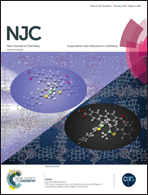A rhodamine embedded bio-compatible smart molecule mimicking a combinatorial logic circuit and ‘key-pad lock’ memory device for defending against information risk†
Abstract
Organic molecules with the possibility of logic operations are highly useful building blocks for the development of molecule-based “intelligent” devices for information processing applications. We have designed herein a very simple bio-friendly chemosensor (LC) equipped with a rhodamine fluorophore moiety. This probe showed a chromo-fluorescence response profile for Al3+ but a colorimetric response for Cu2+ metal. The absorption responses of LC caused by these metal ions along with the “OFF–ON–OFF” fluorescence behavior of an LC–Al3+ complex towards EDTA were employed for the development of a three-input and one output combinatorial molecular system. Interactions of the mentioned metal ions with LC in controlled sequential experiments gave fluorescence responses, enabling us to fabricate a ‘key-pad-logic’ function. So, a single molecular system performing such multiple ‘Boolean’ operations not only simplifies the complexity of a chemical driven ‘Intelligence’ device but also enriches the security of such a device against information invasion due to the sequence controlled sensor–analyte interactions and may find potential applications in biocompatible molecular logic platforms.


 Please wait while we load your content...
Please wait while we load your content...